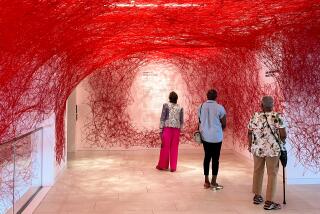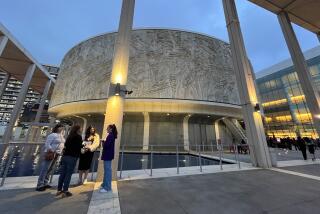Muckenthaler Will Try to Go It Alone : Center, Facing Shrinking Pool of Public Money, Plans for Gradual Elimination of City Funding
FULLERTON — Sensing that the tide of municipal support for arts is still receding, officials at the city-owned and operated Muckenthaler Cultural Center are drafting a plan to become self-supporting for the first time in the center’s 23-year existence.
“Government funds are dwindling and (more) arts cuts will be made,” Jane Parker, board chairwoman of the private, nonprofit Muckenthaler Cultural Center Foundation, said Monday.
The Fullerton City Council will have to approve the plan, which Parker expects to submit in draft form to city officials this month.
Parker refused to discuss specifics until the council sees the draft. But she said the new arrangement will call for a gradual elimination of city funding, although the city would continue to own the center and would lease it to the foundation.
For fiscal year 1992-93, the city of Fullerton is spending about $300,000 for center staffing, building upkeep and such overhead costs as electricity, and landscaping of the center’s eight-acre grounds, said Fullerton City Manager James L. Armstrong.
The Muckenthaler foundation board, which sets policy and programming, raises additional funds. This year it expects to spend about $100,000 on operations, including programs, foundation treasurer Deborah White said.
City support has been slashed by about 25% in recent years, Muckenthaler officials say. Such cuts forced the cancellation of an exhibit that would have opened in April, they say. This will leave the galleries dark during a regular season for the first time in at least eight years (although an abbreviated show featuring Cal State Fullerton graduate students will partly fill in the gaps).
Further, the city is projecting a gaping budget deficit of about $4.2 million for fiscal 1993-94, according to city officials. That is nearly 9% of the total $47-million budget.
“The city is in the worst financial shape that it’s been in in several years,” said Susan Hunt, director of community services. “Clearly there will be fewer dollars available in the future for Muckenthaler. We’re looking at fewer dollars for all city programs.”
Center trustees began to seriously contemplate self-sufficiency about six months ago, Parker said. They approached city officials, who asked to see a specific plan.
Said Armstrong: “I’d characterize it as an interesting proposition that may have some potential, but we need to see the details. They are concerned, as we are, about (the city’s) ability to continue to provide (the same) level of funding.”
To achieve self-sufficiency, the center would seek some state or federal government grants, and solicit funds from individuals, private corporations and foundations, in addition to relying on operating revenues and memberships.
In fact, the board has already begun to go after corporate funding for the first time, said Parker, adding that privatization may improve the center’s fund-raising success.
“People tend to be more generous to private institutions than to entities they feel the city or the government is responsible for,” she said.
Programming at the Muckenthaler, which includes both contemporary and traditional art exhibitions, would not change under the new arrangement, Parker said. “I’m sure we’ll continue to present everything, without an emphasis on anything in particular.”
Officials at the Fullerton Museum Center, Fullerton’s other major visual arts institution, have suffered from city funding budget cuts too. They cited the cuts in their decision last April to close their doors one day a week.
Museum Center trustees aren’t panicking about the Muckenthaler plan’s potential for increasing competition for private funds, however, director Joe Felz said.
Museum Center applications for foundation or state and federal grants request funds for specific educational programs or exhibits, which aren’t likely to duplicate Muckenthaler’s requests, he said.
Parker didn’t see any need for concern.
“Everyone is competing all the time anyway,” she said.
Muckenthaler trustees have sought advice from the Bowers Museum of Cultural Art, which is working toward independence from the city of Santa Ana.
Beginning in 1997, the Bowers’ level of city support will drop 10% annually over the next decade, leaving the museum--through its private nonprofit Charles W. Bowers Museum Corp.--to fend for itself by the year 2007.
Bowers officials suggested that the Muckenthaler board aim for a gradual withdrawal of city support and that the board consider renting the graceful, 70-year-old building for special, catered events, such as weddings or business meetings, to raise additional revenue, just as the Bowers does, Bowers spokesman Brian Langston said.
An endowment and capital campaign, which funded the Muckenthaler’s new outdoor amphitheater, includes provisions for a dining and entertainment area, Parker said.
More to Read
The biggest entertainment stories
Get our big stories about Hollywood, film, television, music, arts, culture and more right in your inbox as soon as they publish.
You may occasionally receive promotional content from the Los Angeles Times.










